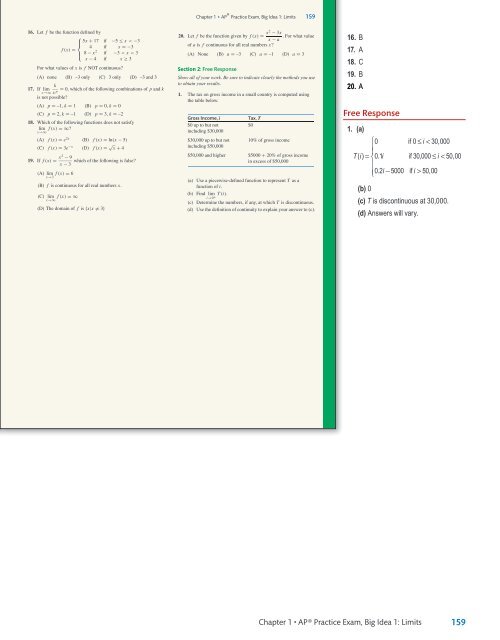Sullivan Microsite DigiSample
Create successful ePaper yourself
Turn your PDF publications into a flip-book with our unique Google optimized e-Paper software.
<strong>Sullivan</strong> AP˙<strong>Sullivan</strong>˙Chapter01 October 8, 2016 17:4<br />
Chapter 1 • AP ® Practice Exam, Big Idea 1: Limits 159<br />
16. Let f be the function defined by<br />
⎧<br />
5x + 17 if −5 ≤ x < −3<br />
⎪⎨<br />
4 if x =−3<br />
f (x) =<br />
⎪⎩<br />
8 − x 2 if −3 < x < 3<br />
x − 4 if x ≥ 3<br />
For what values of x is f NOT continuous?<br />
(A) none (B) –3 only (C) 3 only (D) –3 and 3<br />
k<br />
17. If lim = 0, which of the following combinations of p and k<br />
x→∞ x p<br />
is not possible?<br />
(A) p = –1, k = 1 (B) p = 0, k = 0<br />
(C) p = 2, k = –1 (D) p = 3, k = –2<br />
18. Which of the following functions does not satisfy<br />
lim f (x) =∞?<br />
x→∞<br />
(A) f (x) = e 2x (B) f (x) = ln(x − 5)<br />
(C) f (x) = 3e −x (D) f (x) = √ x + 4<br />
19. If f (x) = x2 − 9<br />
which of the following is false?<br />
x − 3<br />
(A) lim f (x) = 6<br />
x→3<br />
(B) f is continuous for all real numbers x.<br />
(C) lim f (x) =∞<br />
x→∞<br />
(D) The domain of f is {x|x = 3}<br />
20. Let f be the function given by f (x) = x2 − 3x<br />
. For what value<br />
x − a<br />
of a is f continuous for all real numbers x?<br />
(A) None (B) a = –3 (C) a = –1 (D) a = 3<br />
Section 2: Free Response<br />
Show all of your work. Be sure to indicate clearly the methods you use<br />
to obtain your results.<br />
1. The tax on gross income in a small country is computed using<br />
the table below.<br />
Gross Income, i<br />
Tax, T<br />
$0 up to but not<br />
$0<br />
including $30,000<br />
$30,000 up to but not 10% of gross income<br />
including $50,000<br />
$50,000 and higher $5000 + 20% of gross income<br />
in excess of $50,000<br />
(a) Use a piecewise-defined function to represent T as a<br />
function of i.<br />
(b) Find lim<br />
i→0 + T (i).<br />
(c) Determine the numbers, if any, at which T is discontinuous.<br />
(d) Use the definition of continuity to explain your answer to (c).<br />
16. B<br />
17. A<br />
18. C<br />
19. B<br />
20. A<br />
Free Response<br />
1. (a)<br />
⎧0 if 0≤ i < 30,000<br />
⎪<br />
Ti () = ⎨0.1i<br />
if 30,000 ≤ i < 50,00<br />
⎪<br />
⎩⎪<br />
0.2i− 5000 if i > 50,00<br />
(b) 0<br />
(c) T is discontinuous at 30,000.<br />
(d) Answers will vary.<br />
Chapter 1 • AP® Practice Exam, Big Idea 1: Limits<br />
159<br />
TE_<strong>Sullivan</strong>_Chapter01_PART II.indd 42<br />
11/01/17 9:57 am




